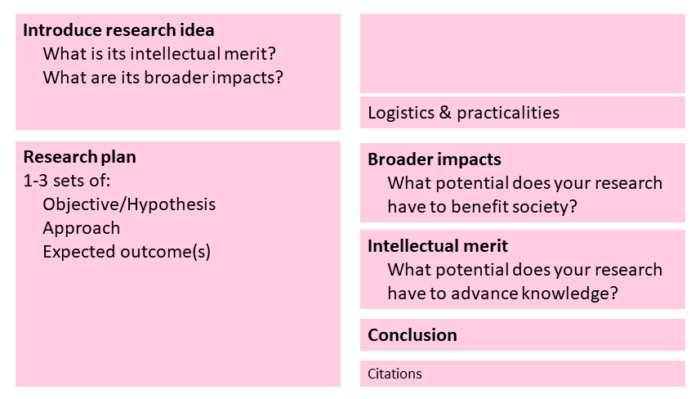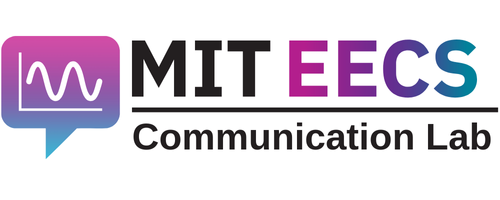Criteria for Success
- You are eligible for the Fellowship (Be certain to check for restrictions, i.e., only U.S. citizens, nationals, and permanent residents are eligible.)
- Your research proposal convinces a panel of academics that you are qualified to receive the Fellowship, especially with respect to the Intellectual Merit and Broader Impact criteria.
- You show that the proposed research is creative, original, and transformative.
- You show that you are actually capable of performing the research.
- Your proposal meets the formatting and page limit criteria.
- Text is grammatically correct and free of typos.
Structure Diagram

According to NSF guidelines, “Intellectual Merit” and “Broader Impacts” should be addressed under separate headings. Otherwise, the titles, sizes, and order of sections is flexible within the two-page limit. One example breakdown is shown in the diagram above.
Applications prior to 2018 did not require “Intellectual Merit” and “Broader Impacts” to be addressed under separate headings. Be sure to follow the most up-to-date guidelines provided by NSF, especially if you are referencing older examples.
Purpose
Your research proposal (technically, the “Graduate Research Plan Statement”) is the part of the NSF application where you have an opportunity to lay out a plan for your graduate research career. While the personal statement gives you space to explain the big picture of your past and future career, the research proposal is a place for more detail. Your goal is to convince the selection panel that you are capable of being a successful researcher: that you have the intellectual ability to propose a creative, feasible plan of research.
Unlike many funding opportunities, the NSF GRFP is designed to fund a person rather than a project. The goal of your research proposal is to show that you can propose feasible, original research of an appropriate scope. Even if you are awarded the Fellowship, you will not be limited to the details described in your research proposal.
Analyze Your Audience
Your entire application will be reviewed by “disciplinary and interdisciplinary scientists and engineers, and other professional graduate education experts.” These are academics, usually from your broad area of science (e.g., materials research) but not from your specific area (e.g., optoelectronics). They will judge your application using some combination of the NSF’s official criteria for the Fellowship and their own ideas about what constitutes good science.
The people on the committee read many, many applications. Make it easy for them to figure out that you are qualified for the award by referencing the Intellectual Merit and Broader Impact criteria that they use to judge your application. It may be wise to have an “Abstract” or “Executive Summary” at the beginning of the proposal. Use simple language rather than field-specific jargon.
The selection panel knows that this application is for a graduate student fellowship and not for a large grant that might go to a principal investigator. Real grant proposals are big documents with heaps of citations and references. Because this application is about funding you, rather than funding a specific project, the panel is more interested in seeing what your proposal says about you and your ability to write a good proposal rather than about your proposed research. Be sure to keep an emphasis on showing that you are capable and creative, and cite only papers you feel are necessary to provide directly related background (or to highlight your own relevant research if applicable).
Skills
Include Intellectual Merit and Broader Impact criteria
The NSF GRFP criteria emphasize “Intellectual Merit” and “Broader Impacts.” Do not just make up your own ideas about what these terms mean. Read the solicitation so you know what “Intellectual Merit” and “Broader Impacts” mean to the NSF, and show that your proposed research meets those criteria. This is the arguably the most important step in preparing your proposal, because it is by these criteria that your application will be evaluated.
In the 2023 solicitation, NSF defines these terms: “The Intellectual Merit criterion encompasses the potential to advance knowledge… The Broader Impacts criterion encompasses the potential to benefit society and contribute to the achievement of specific, desired societal outcomes.” The NSF also has specific lists of activities that constitute Broader Impacts.
Be sure to include Broader Impacts and Intellectual Merit throughout your proposal as well as in separate, labeled sections. According to the 2023 solicitation, “Applications that do not have separate headings for Intellectual Merit and Broader Impacts will not be reviewed.”
Do your homework
A mature and sophisticated proposal for research is more likely to win you the Fellowship. Before sitting down to write, do your homework. Read many papers from the field in which you are proposing research. Make sure the research you are proposing to do hasn’t been done before or isn’t generally regarded as impossible.
Established researchers in your field can also be an excellent resource as you write your proposal. More senior scientists like postdocs and faculty members have a lot of experience crafting research proposals, and they are similar to the kinds of people who will be reviewing your proposal. Finally, your proposal should also be exciting to someone who is in your research area. If a scientist in your field has reservations about whether your project is worth funding, then scientists from other areas might have an even more difficult time believing the research is worth pursuing.
Demonstrate creativity while maintaining credibility
In any research proposal, there is a tradeoff between risk/reward and credibility. Low risk projects, like obvious, simple extensions of your undergraduate thesis research, tend to be very credible: it’s clear that you can do them. They also tend to be low on reward. Projects that are very ambitious and have huge rewards tend to be unbelievable and impossible for a grad student. The key to a successful application frequently involves finding the optimum balance between the two: find a problem that you can probably solve and that demonstrates that you took some initiative, understand your field, and have some creative thoughts.
Relatedly, your research proposal will be judged, in part, on the basis of whether or not the panel members believe you will actually be able to carry it out. It might therefore be wise to name the key resources in your target institution and program. Your success as a graduate student will depend on your advisor’s mentorship, the opportunity for collaboration with other scientists, and the resources that you will have at your target institution. Make it clear that you will have the right equipment and intellectual input that you will need to solve your problem.
Write to a fatigued, non-field-specific audience
It’s more important that all the members of your panel understand your work than that you impress the one member of the panel who happens to be in your field. When you write a paper or a grant, it will probably be minutely reviewed by people much closer to your field of study. However, your panel for the NSF GRFP will not be nearly as field specific, and your application will be one of many that they read. They may very well miss points in your proposal that you think are “subtle” or “implicit.” Explicitly tell them what you’re doing and why, and make it clear even to someone who doesn’t know your field and who may be exhausted after reading many applications.
Lay out concrete hypotheses, approaches, and outcomes
Strong research proposals say what motivates the project, how the project will get done, and what the project’s outcome will mean with respect to the motivating scientific question.
When discussing research approach and outcomes, make it clear that the project has a clear endpoint that is well within the timeline of a Ph.D. It’s great if your project leads into a lifelong line of research, but the NSF GRFP only funds graduate study. To be awarded the Fellowship, you need to be able to complete the proposed research in a few years.
As best you can, describe concrete approaches and outcomes: e.g. Will you develop a new algorithm or design a certain tool? What output will your research generate? Having concrete outcomes can additionally help you show how your proposed research will meet the Intellectual Merit and Broader Impacts criteria by allowing you to point to specific effects it will have on society.
Content adapted by the MIT Electrical Engineering and Computer Science Communication Lab from an article originally created by the MIT Biological Engineering Communication Lab.
